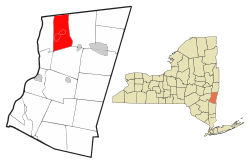Kinderhook Academy
| Kinderhook, New York | |
|---|---|
| Town | |

Main square in Kinderhook
|
|
 Location of Kinderhook, New York |
|
| Coordinates: 42°24′46″N 73°40′53″W / 42.41278°N 73.68139°WCoordinates: 42°24′46″N 73°40′53″W / 42.41278°N 73.68139°W | |
| Country | United States |
| State | New York |
| County | Columbia |
| Settled | 1750 |
| Established | 1788 |
| Government | |
| • Type | Town Council |
| • Town Supervisor | Patrick M. Grattan (R) |
| • Town Council |
Members' List
|
| Area | |
| • Total | 32.4 sq mi (83.9 km2) |
| • Land | 31.8 sq mi (82.4 km2) |
| • Water | 0.6 sq mi (1.6 km2) |
| Elevation | 239 ft (73 m) |
| Population (2010) | |
| • Total | 8,498 |
| • Density | 267/sq mi (103.2/km2) |
| Time zone | Eastern (EST) (UTC-5) |
| • Summer (DST) | EDT (UTC-4) |
| ZIP code | 12106 |
| Area code(s) | 518 |
| FIPS code | 36-39573 |
| GNIS feature ID | 0979116 |
| Website | www |
Kinderhook is a town in the northern part of Columbia County, New York, United States. The population was 8,498 at the 2010 census, the most populous municipality in Columbia County. The name of the town means "Children's Corner" in the language of the original Dutch settlers (Kinderhoek). The name "Kinderhook" has its root in the landing of Henry Hudson in the area around present-day Stuyvesant, where he was greeted by Native Americans with many children. With the Dutch Kinder meaning "child" and Hoeck meaning "bend" or "hook" [in the river], the name literally means "bend in the river where the children are".
The town of Kinderhook contains two villages, one of which is also named Kinderhook, where the eighth President of the United States, Martin Van Buren, was born; the other is the village of Valatie. In addition, the town contains the hamlet of Niverville, next to Kinderhook Lake.
In 1609 Henry Hudson sailed as far north as Kinderhook on his exploration of the Hudson River and named the location "Kinderhoek".Kinderhook signifies in the Dutch tongue "the children's corner", and is supposed to have been applied to this locality, in 1609, on account of the many Indian children who had assembled on one of the bluffs along the river to see his strange vessel (the Half Moon) sailing upstream. Another version says that a Swede named Scherb, living in the forks of an Indian trail in the present town of Stuyvesant, had such a numerous family of children that the name of Kinderhook was used by the Dutch traders to designate that locality. Hudson had mixed dealing with the local Mohican natives, ranging from peaceful trade to minor skirmishes. As the Dutch attempted to colonize the area, further warfare broke out with the natives.
...
Wikipedia
